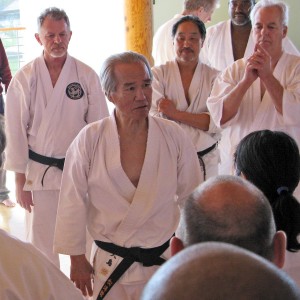Karate’s pre-history can be traced back to Daruma (aka Bodhidharma), founder of Zen Buddhism in Western India. Daruma is said to have introduced Buddhism into China somewhere around the year 500 CE, incorporating spiritual and physical teaching methods that were so demanding that many of his disciples would drop in exhaustion. In order to give them greater strength and endurance, he developed a more progressive training system. Daruma’s book, Ekkin-Kyo, can be considered the first book on martial arts, and his training and philosophy were adopted by the Shaolin Temple in northern China.
The modern history of karate begins in Okinawa. Okinawa-te (Okinawan hand), or simply te, was a simple but highly effective method evolving through centuries of use in real combat. The banning of weapons on the island for two long periods in its history contributed to the high degree of development of this method. But Okinawa-te was also influenced by the much more elaborate techniques and philosophical teachings of Shaolin kung fu and China’s southern Shokei style. These origins explain the dual nature of karate: extremely violent and efficient but at the same time a strictly disciplined philosophy with a nonviolent emphasis.
The Influence of Master Funakoshi
In 1916 Master Gichin Funakoshi became the first expert to introduce karate-do from Okinawa to mainland Japan. One of the few people to have been initiated into all the major Okinawan karate methods, Master Funakoshi taught a synthesis of the Okinawan styles as a total discipline. This method became known as Shotokan (literally “House of Shoto,” Funakoshi’s pen name as a poet). Because the style became very popular in Japan and proceeded to spread throughout the world, Funakoshi is widely considered to be the “father of modern karate-do.”

Ron Thom (SKA President), Tsutomu Ohshima (Shihan), John Teramoto (BBC President), Norman Welch (Canada Shotokan President)
The Influence of Tsutomu Ohshima
Tsutomu Ohshima was one of Master Funakoshi’s last direct pupils (1948-1953), studying under him while attending Waseda University in Tokyo, Japan. In 1955 Mr. Ohshima came to the United States and was the first person to teach karate to the US public; in 1957 he made the first public demonstration of traditional Shotokan karate in the United States, at the annual Nisei Week festival in Los Angeles. The following year (1958) Mr. Ohshima presided over a full karate tournament at Nisei Week, as he has done every year since; SKA’s Nisei Week event is the oldest annual karate tournament in the US.
In 1959 the Southern California Karate Association (SCKA) was formed, which grew to become a nationwide organization, Shotokan Karate of America (SKA). Ohshima Sensei has since been recognized as shihan (chief instructor) of many other national organizations; thus his influence on karate is felt globally.
Today thousands of Ohshima Sensei’s black belts are training and teaching throughout the world, maintaining their commitment to authentic, traditional karate-do and doing their best to provide an answer to the question posed by Master Funakoshi: “The Way: Who will pass it on straight and well?”
Resource: http://ska.org/
Không có nhận xét nào:
Đăng nhận xét